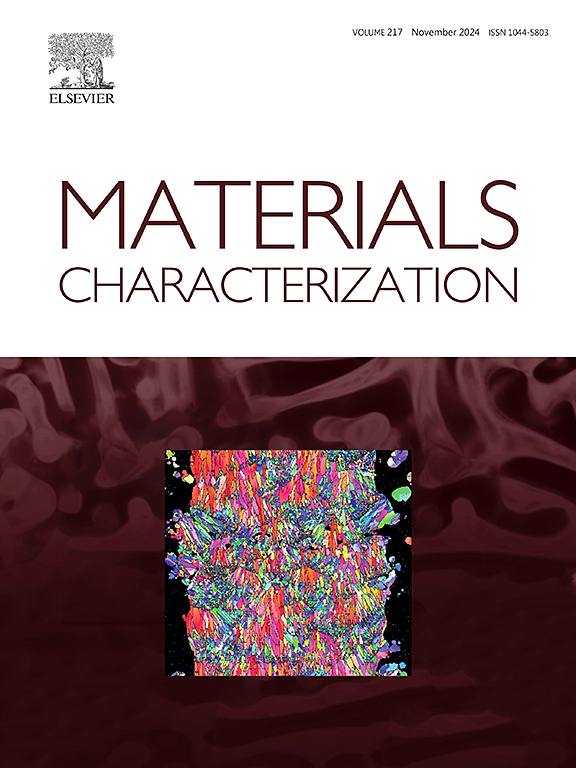Effect of partitioning time on the microstructure and properties of chemical heterogeneous quenched and partitioned steels
IF 4.8
2区 材料科学
Q1 MATERIALS SCIENCE, CHARACTERIZATION & TESTING
引用次数: 0
Abstract
Introducing chemical heterogeneity in high-temperature austenite has been proven to be an effective way to tailor retained austenite and achieve a good balance of strength and ductility. Here, we have studied the role of Mn heterogeneity in carbon diffusion from Mn-depleted martensite to Mn-enriched austenite in Si/Al-free quenching & partitioning (Q&P) steels. The Mn heterogeneity in high-temperature austenite is constructed through fast and short austenitization from Mn-partitioned pearlite; following quenching, alternative Mn-enriched film RA and Mn-depleted martensitic lath are obtained. The effect of partitioning time on carbon diffusion, microstructural evolution and tensile properties is systematically investigated. Interestingly, carbide precipitation is absent in Mn-depleted martensite; instead, carbon atoms diffuse from lath martensite to the neighboring austenite. After 5 min partitioning, the carbon distribution in austenite is uneven, making the austenite with low Mn concentration transform into martensite and forming untempered ghost pearlite. After 120 min partitioning, carbon distribution in austenite becomes more uniform, with average carbon concentration of 5.22 ± 0.22 at. %, which stabilizes the austenite at room temperature. This leads to the formation of tempered ghost pearlite. Consequently, increasing partitioning time from 5 to 240 min, the width of film RA increases from 42.1 ± 10.3 to 53.8 ± 14.1 nm; meanwhile, the RA fraction keeps around 20 %, which are beneficial to ductility. But the formation of fresh martensite after short-time partitioning and the decomposition of film RA after long-time partitioning are both detrimental to the ductility. Additionally, the decrease in yield strength with increasing partitioning time is attributed to the decrease in carbon concentration and dislocation density in martensitic matrix.
配分时间对化学非均质淬火配分钢组织和性能的影响
在高温奥氏体中引入化学非均质性已被证明是调整残余奥氏体,实现强度和塑性良好平衡的有效途径。本文研究了无Si/ al淬火中Mn非均质性在碳从贫Mn马氏体向富Mn奥氏体扩散中的作用;划分(Q&;P)钢。Mn在高温奥氏体中的非均质性是通过Mn分割珠光体快速而短暂的奥氏体化形成的;淬火后得到富锰膜RA和贫锰马氏体板条。系统地研究了分配时间对碳扩散、微观组织演化和拉伸性能的影响。有趣的是,贫锰马氏体中没有碳化物析出;相反,碳原子从板条马氏体扩散到邻近的奥氏体。分配5 min后,奥氏体中的碳分布不均匀,使低Mn浓度的奥氏体转变为马氏体,形成未回火的鬼珠光体。分配120 min后,碳在奥氏体中的分布更加均匀,平均碳浓度为5.22±0.22 at。%,使奥氏体在室温下稳定。这导致回火幽灵珠光体的形成。因此,随着分配时间从5 min增加到240 min,膜RA的宽度从42.1±10.3 nm增加到53.8±14.1 nm;同时,RA含量保持在20%左右,有利于塑性。但短时配分后新马氏体的形成和长时间配分后膜RA的分解都不利于塑性。另外,随着分配时间的增加,屈服强度的降低是由于马氏体基体中碳浓度和位错密度的降低。
本文章由计算机程序翻译,如有差异,请以英文原文为准。
求助全文
约1分钟内获得全文
求助全文
来源期刊

Materials Characterization
工程技术-材料科学:表征与测试
CiteScore
7.60
自引率
8.50%
发文量
746
审稿时长
36 days
期刊介绍:
Materials Characterization features original articles and state-of-the-art reviews on theoretical and practical aspects of the structure and behaviour of materials.
The Journal focuses on all characterization techniques, including all forms of microscopy (light, electron, acoustic, etc.,) and analysis (especially microanalysis and surface analytical techniques). Developments in both this wide range of techniques and their application to the quantification of the microstructure of materials are essential facets of the Journal.
The Journal provides the Materials Scientist/Engineer with up-to-date information on many types of materials with an underlying theme of explaining the behavior of materials using novel approaches. Materials covered by the journal include:
Metals & Alloys
Ceramics
Nanomaterials
Biomedical materials
Optical materials
Composites
Natural Materials.
 求助内容:
求助内容: 应助结果提醒方式:
应助结果提醒方式:


